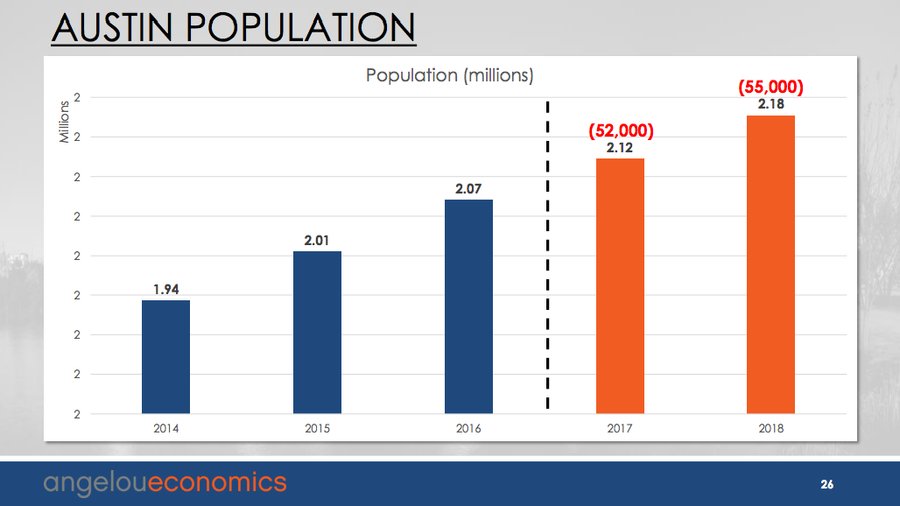More than 100,000 new residents will arrive in Austin over the next two years as the population and economy continue to grow, but at a slightly slower pace than what the region is used to.
That was the broad takeaway from economist Angelos Angelou's annual economic forecast, delivered Thursday in an inaugural web conference hosted with Austin Business Journal. Angelou is the founder and principal at AngelouEconomics, an Austin-based economic consultancy that has been producing regional economic forecasts for more than 30 years.
Angelou predicts the Austin region will add 52,000 residents in 2017 and 55,000 residents in 2018, raising the region's population from 2.07 million in 2016 to 2.18 million in 2018. Further, he predicted that Austin will add 29,000 jobs in 2017 and 34,500 jobs in 2018, growing local employment by more than 3 percent each year.
But while recent economic indicators from the Federal Reserve Bank of Dallas shown signs of weakening local economic growth, Austin's economy will remain relatively strong compared to other major U.S. metros, according to Angelou.
"The economy is cooling off, but don't panic," he said. "Cooling off is good news for us. It will hopefully lead to housing and labor markets catching up with demand."
Job growth comes with challenges
Austin's unemployment rate has been very low for a long time now, hovering near 3 percent for more than a year. While that's good news for job seekers, who hold an advantage in salary negotiations when unemployment rates are low, it can also hurt economic expansion as employers have to pay higher salaries in a more competitive environment.
Local industries where job growth is the fastest — such as education, leisure and hospitality and professional and business services — have actually seen some of the slowest rates of wage growth.
"Job growth does not equate to job quality in Austin," Angelou said.
Case in point: One of the region's fastest-growing job sectors over the next two years will be trade, transportation and utilities, with Angelou forecasting 5,000 new jobs in those industries in 2017 followed by 6,200 new jobs in 2018. Regional employment in that sector has grown by more than 10 percent since 2012, but wages within the sector in the region have fallen slightly in that time. It is the only sector in Austin to see wages shrink over the past three years.
Meanwhile, Angelou said retail sales in the Austin region would grow at a slower pace than in recent years, expanding between 5 and 6 percent annually over the next two years. In 2016, retail sales growth spiked more than 9 percent to $39.1 billion. The year before, regional retail sales expanded by roughly 6.5 percent to $35.8 billion.
Residential, commercial real estate
Angelou expects 3.1 million square feet of office space, 2.4 million square feet of retail space and 4.2 million square feet of flex-industrial space would be built over the next two years. He also said 26,000 new single-family units and 24,000 multi-family units would be absorbed over the next two years, indicating persistent demand for new housing options.
But affordability — at both the commercial and residential levels — remains a big challenge. Austin-area renters typically pay about 30 percent of their income toward rent, just a hair less than San Francisco renters. Further, 25 percent of Austin-area renters spend more than 50 percent of their income on housing. Single family-home prices have increased faster than wages in the region, making it harder for the typical household to afford a house.
Home prices have increased between 7 and 8 percent annually each of the past three years. In that same time, average wage growth in the region has fluctuated between 3.8 percent and 0.3 percent.
Commercial real estate likewise remains more expensive in Austin than in other major Texas metros in almost all categories. At $34.83 per square foot for office space and $9.27 per square foot for industrial space, Austin is more expensive than Dallas and Houston. Retail is the sole exception, where Houston takes the cake at nearly $25 per square foot compared with $20.93 in Austin.
Still, Austin has a tight retail real estate market, with a mere 3.5 percent vacancy rate. Since 2011, office rents have risen by 31.6 percent, industrial rents have risen by 37.9 percent and retail rents have increased by 18.9 percent.
Mobility blues
Angelou also identified traffic congestion as a major challenge for Austin's economy. He noted that Austin has the seventh-worst traffic congestion in the U.S., in league with Seattle and San Jose, California. The solution, Angelou said, is to invest in a wide variety of transportation infrastructure to deal with expected population growth over the next 25 years. During that time, Austin is expected to grow to a regional population of more than 4 million residents.
"Housing affordability and mobility are our biggest challenges," Angelou said. "How we address those issues is going to impact how long a boom we will have. If we fail to make those investments, then I fear our economic development could come to a halt."


